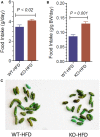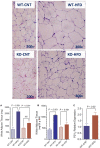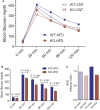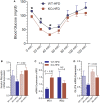P2Y2 Receptor Promotes High-Fat Diet-Induced Obesity
- PMID: 32582029
- PMCID: PMC7283874
- DOI: 10.3389/fendo.2020.00341
P2Y2 Receptor Promotes High-Fat Diet-Induced Obesity
Abstract
P2Y2, a G protein-coupled receptor (R), is expressed in all organs involved in the development of obesity and insulin resistance. To explore the role of it in diet-induced obesity, we fed male P2Y2-R whole body knockout (KO) and wild type (WT) mice (B6D2 genetic background) with regular diet (CNT; 10% calories as fat) or high-fat diet (HFD; 60% calories as fat) with free access to food and water for 16 weeks, and euthanized them. Adjusted for body weights (BW), KO mice consumed modestly, but significantly more HFD vs. WT mice, and excreted well-formed feces with no taint of fat or oil. Starting from the 2nd week, HFD-WT mice displayed significantly higher BW with terminal mean difference of 22% vs. HFD-KO mice. Terminal weights of white adipose tissue (WAT) were significantly lower in the HFD-KO vs. HFD-WT mice. The expression of P2Y2-R mRNA in WAT was increased by 2-fold in HFD-fed WT mice. Serum insulin, leptin and adiponectin levels were significantly elevated in the HFD-WT mice, but not in the HFD-KO mice. When induced in vitro, preadipocytes derived from KO mice fed regular diet did not differentiate and mature as robustly as those from the WT mice, as assessed by cellular expansion and accumulation of lipid droplets. Blockade of P2Y2-R by AR-C118925 in preadipocytes derived from WT mice prevented differentiation and maturation. Under basal conditions, KO mice had significantly higher serum triglycerides and showed slightly impaired lipid tolerance as compared to the WT mice. HFD-fed KO mice had significantly better glucose tolerance (GTT) as compared to HFD-fed WT mice. Whole body insulin sensitivity and mRNA expression of insulin receptor, IRS-1 and GLUT4 in WAT was significantly higher in HFD-fed KO mice vs. HFD-fed WT mice. On the contrary, the expression of pro-inflammatory molecules MCP-1, CCR2, CD68, and F4/80 were significantly higher in the WAT of HFD-fed WT vs. HFD-fed KO mice. These data suggest that P2Y2-R plays a significant role in the development of diet-induced obesity by promoting adipogenesis and inflammation, and altering the production of adipokines and lipids and their metabolism in adipose tissue, and thereby facilitates HFD-induced insulin resistance.
Keywords: AR-C 118925; adipose tissue; glucose homeostasis; inflammation; insulin resistance; lipid tolerance; obesity; purinergic signaling.
Copyright © 2020 Zhang, Ecelbarger, Lesniewski, Müller and Kishore.
Figures












Similar articles
-
A platelet-activating factor (PAF) receptor deficiency exacerbates diet-induced obesity but PAF/PAF receptor signaling does not contribute to the development of obesity-induced chronic inflammation.Biochem Pharmacol. 2015 Feb 15;93(4):482-95. doi: 10.1016/j.bcp.2014.12.022. Epub 2015 Jan 8. Biochem Pharmacol. 2015. PMID: 25577975
-
Deletion of H-ferritin in macrophages alleviates obesity and diabetes induced by high-fat diet in mice.Diabetologia. 2020 Aug;63(8):1588-1602. doi: 10.1007/s00125-020-05153-0. Epub 2020 May 19. Diabetologia. 2020. PMID: 32430665
-
Female mice target deleted for the neuromedin B receptor have partial resistance to diet-induced obesity.J Physiol. 2010 May 1;588(Pt 9):1635-45. doi: 10.1113/jphysiol.2009.185322. Epub 2010 Mar 8. J Physiol. 2010. PMID: 20211980 Free PMC article.
-
Vitamin A Supplementation during Suckling and Postweaning Periods Attenuates the Adverse Metabolic Effects of Maternal High-Fat Diet Consumption in Sprague-Dawley Rats.Curr Dev Nutr. 2020 Jun 27;4(8):nzaa111. doi: 10.1093/cdn/nzaa111. eCollection 2020 Aug. Curr Dev Nutr. 2020. PMID: 32734136 Free PMC article. Review.
-
Impact of Short-Term Lipid Overload on Whole-Body Physiology.Mol Cell Biol. 2025;45(2):47-58. doi: 10.1080/10985549.2024.2438814. Epub 2024 Dec 27. Mol Cell Biol. 2025. PMID: 39726368 Review.
Cited by
-
The Adenosine Pathway and Human Immunodeficiency Virus-Associated Inflammation.Open Forum Infect Dis. 2021 Jul 24;8(9):ofab396. doi: 10.1093/ofid/ofab396. eCollection 2021 Sep. Open Forum Infect Dis. 2021. PMID: 34557556 Free PMC article. Review.
-
Resveratrol and Quercetin as Regulators of Inflammatory and Purinergic Receptors to Attenuate Liver Damage Associated to Metabolic Syndrome.Int J Mol Sci. 2021 Aug 19;22(16):8939. doi: 10.3390/ijms22168939. Int J Mol Sci. 2021. PMID: 34445644 Free PMC article.
-
High-Fat Diet-Induced Renal Proximal Tubular Inflammatory Injury: Emerging Risk Factor of Chronic Kidney Disease.Front Physiol. 2021 Dec 7;12:786599. doi: 10.3389/fphys.2021.786599. eCollection 2021. Front Physiol. 2021. PMID: 34950058 Free PMC article. Review.
-
The P2Y2 receptor mediates terminal adipocyte differentiation and insulin resistance: Evidence for a dual G-protein coupling mode.J Biol Chem. 2024 Feb;300(2):105589. doi: 10.1016/j.jbc.2023.105589. Epub 2023 Dec 21. J Biol Chem. 2024. PMID: 38141758 Free PMC article.
-
Absence of P2Y2 Receptor Does Not Prevent Bone Destruction in a Murine Model of Muscle Paralysis-Induced Bone Loss.Front Endocrinol (Lausanne). 2022 May 26;13:850525. doi: 10.3389/fendo.2022.850525. eCollection 2022. Front Endocrinol (Lausanne). 2022. PMID: 35721713 Free PMC article.
References
Publication types
MeSH terms
Substances
Grants and funding
LinkOut - more resources
Full Text Sources
Medical
Molecular Biology Databases
Research Materials
Miscellaneous

